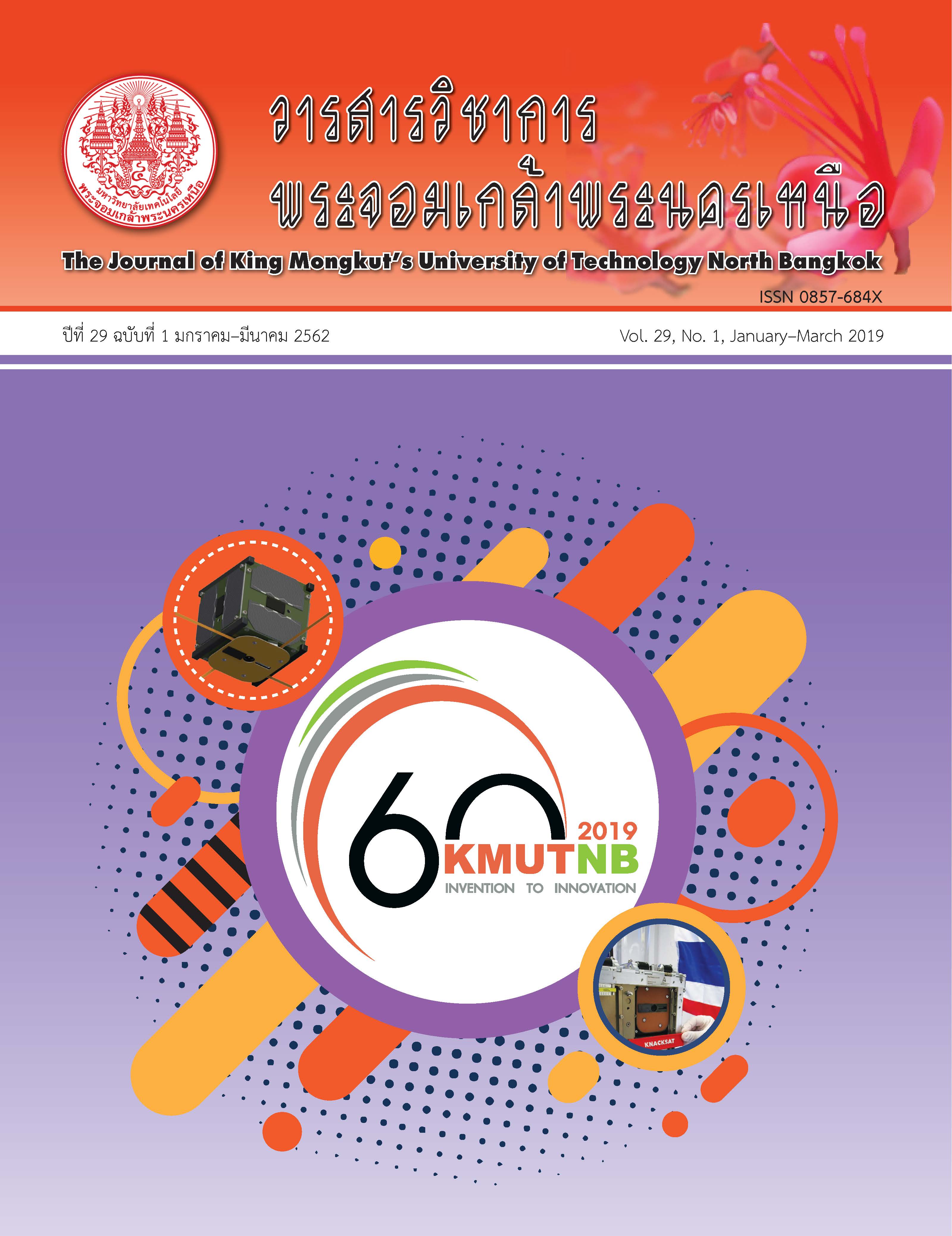การพัฒนาแบบจำลองวงจรตรรกะสังเคราะห์บนยีนด้วยขั้นตอนวิธีเชิงพันธุกรรม
Main Article Content
บทคัดย่อ
บทความนี้ได้กล่าวถึงการนำวิธีการทางวิศวกรรมมาประยุกต์ใช้ในการศึกษาและพัฒนาแบบจำลองของกระบวนการแสดงออกของยีน ซึ่งการแสดงออกของยีนนั้นจะอยู่ในรูปของโปรตีน โดยการนำแนวคิดของกระบวนการลอกรหัสของ lac operon ที่มีกระบวนการทำงานที่เสมือนกับวงจรอิเล็กทรอนิกส์ ซึ่งสามารถพิจารณาด้วยสถานะของการทำงานแบบ On และ Off ได้ โดยมีตัวกระตุ้นหนึ่งหรือสองตัวที่เปรียบเสมือนการป้อนค่าอินพุตให้กับวงจร แบบจำลองการทำงานนี้ใช้ขั้นตอนวิธีเชิงพันธุกรรม (Genetic Algorithm) มาช่วยในการค้นหาค่าพารามิเตอร์ที่มีความเหมาะสมที่สุด เพื่อให้การคำนวณปริมาณการเกิดผลผลิตโปรตีนของกระบวนการลอกรหัสที่มีความเข้มข้นของตัวกระตุ้นที่แตกต่างกันนั้นได้ผลลัพธ์ที่มีความถูกต้อง ผลของการออกแบบเกตตรรกะสังเคราะห์พื้นฐานเหล่านี้สามารถนำไปขยายเป็นวงจรตรรกะสังเคราะห์ที่มีความซับซ้อนมากขึ้นได้
Article Details
บทความที่ลงตีพิมพ์เป็นข้อคิดเห็นของผู้เขียนเท่านั้น
ผู้เขียนจะต้องเป็นผู้รับผิดชอบต่อผลทางกฎหมายใดๆ ที่อาจเกิดขึ้นจากบทความนั้น
เอกสารอ้างอิง
[2] G. Cuccato, G. D. Gatta, and D. di Bernardo, “Systems and synthetic biology: Tackling genetic networks and complex diseases,” Heredity, vol. 102, no. 6, pp. 527–532, 2009.
[3] A. S. Khalil and J. J. Collins, “Synthetic biology: Applications come of age,” Nature Reviews Genetics, vol. 11, no. 5, pp. 367–379, 2010.
[4] Y. Naasse, H. Charoute, B. E. Houate, C. Elbekkay, L. Razoki, A. Malki, A. Barakat, and H. Rouba, “Chromosomal abnormalities and Y chromosome microdeletions in infertile men from Morocco,” BMC Urology, vol. 95, no. 15, pp. 2–6, 2015.
[5] L. Bintu, N. E. Buchler, H. G. Garcia, U. Gerland, T. Hwa, J. Kondev, T. Kuhlman, and R. Phillips, “Transcriptional regulation by the numbers: Applications,” Current Opinion in Genetics & Development, vol. 15, no. 2, pp. 125–135, 2005.
[6] M. N. Win and C. D. Smolke, “Higher-order cellular information processing with synthetic RNA devices,” Science, vol. 322, no. 5900, pp. 456–460, 2008.
[7] S. Ausländer, D. Ausländer, M. Müller, M. Wieland, and M. Fussenegger, “Programmable single-cell mammalian biocomputers,” Nature, vol. 487, pp. 123–127, 2012.
[8] K. Hattori, “Advanced biological computer developed,” ScienceDaily, American Technion Society, Rockville, MD, May 2013.
[9] S. Konur and M. Gheorghe, “Design and analysis of genetically constructed logic gates,” in Proceedings of The University of Sheffield Engineering Symposium Conference, 2014, pp. 31–32.
[10] A. Wong, H. Wang, C. L. Poh, and R. I. Kitney, “Layering genetic circuits to build a single cell, bacterial half adder,” BMC Biology, vol. 13, no. 1, pp. 40, 2015.
[11] A. E. Mayo, Y. Setty, S. Shavit, A. Zaslaver, and U. Alon, “Plasticity of the cis-regulatory input function of a gene,” PLoS Biology, vol. 4, no. 4, 2006.
[12] C. H. Yuh, H. Bolouri, and E. H. Davidson, “Genomic cis-regulatory logic: Experimental and computational analysis of a sea urchin gene,” Science, vol. 279, no. 5358, pp. 1896–1902, 1998.
[13] N. E. Buchler, U. Gerland, and T. Hwa, “On schemes of combinatorial transcription logic,” PNAS, vol. 100, no. 9, pp. 5136–5141, 2003.
[14] N. Ichinose, T. Yada, O. Gotoh, and K. Aihara, “Reconstruction of transcription–translation dynamics with a model of gene networks,” Journal of Theoretical Biology, vol. 255, no. 4, pp. 378–386, 2008.
[15] Y. Maki, Y. Takahashi, Y. Arikawa, S. Watanabe, K. Aoshima, Y. Eguchi, T. Ueda, S. Aburatani, S. Kuhara, and S. Okamoto, “An integrated comprehensive workbench for inferring genetic networks: Voyagene,” Journal of Bioinformatics and Computational Biology, vol. 2, no. 3, pp. 533, 2004.
[16] R. S. Cox, M. G. Surette, and M. B. Elowitz, “Programming gene expression with combinatorial promoters,” Molecular Systems Biology, vol. 3, pp. 145, 2007.
[17] C. H. Chuang, C. L. Lin, Y. C. Chang, T. Jennawasin, and P. K. Chen, “Design of synthetic biological logic circuits based on evolutionary algorithm,” IET Systems Biology, vol. 7, no. 4, pp. 89–105, 2013.
[18] T. Pencheva, K. Atanassov, and A. Shannon, “Modelling of a roulette wheel selection operator in genetic algorithms using generalized nets,” International Journal Bioautomation, vol. 13, no. 4, pp. 257–264, 2009.
[19] J. M. Mendes, “A comparative study of crossover operators for genetic algorithms to solve the job shop scheduling problem,” WSEAS Transactions on Computers, vol. 12, no. 4, pp. 164–173, 2013.

